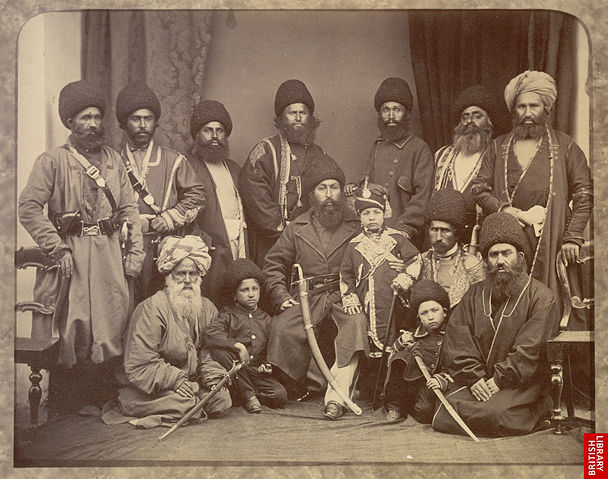| Description |
Group of the Amir Shere Ali, Prince Abdullah Jan, & Sirdars. Photograph taken by John Burke in 1869; a studio portrait of the Amir of Afghanistan, Sher Ali (1825-1879), Prince Abdullah Jan and Afghan sirdars or chiefs, from a series titled 'Photographs of the Amir Shere Ali Khan and Suite'. John Burke accompanied the Peshawar Valley Field Force, one of three British Anglo-Indian army columns deployed in the Second Afghan War (1878-80), despite being rejected for the role of official photographer. He financed his trip by advance sales of his photographs 'illustrating the advance from Attock to Jellalabad'. Coming to India as apothecary with the Royal Engineers, Burke turned professional photographer, assisting William Baker. Travelling widely in India, they were the main rivals to the better-known Bourne and Shepherd. Burke's two-year Afghan expedition produced an important visual document of the region where strategies of the Great Game were played out. This image is part of a special series on Sher Ali at the Ambala Durbar of 1869. The First Afghan War resulted in a defeat for the British in 1842. Ever since, there was a deep desire in the British to lay their writ over Afghanistan. The country tried to stay independent, turbulent due to chaotic struggles for power between relatives. In 1869, a new Amir, Sher Ali, took power. That same year, in an attempt to appease the British he travelled to Ambala near Lahore for a durbar with the Viceroy Lord Mayo. This photograph appears to have been taken at this time. The little boy with Sher Ali was his son and chosen heir. The negotiations at the durbar were ineffective, the Amir resisting the British demand to have an embassy at Kabul which the Afghans would view as an invasion, yet seeking British aid to establish his legitimacy. This was not forthcoming, although they offered him money. |
Permission
( Reusing this image) |
|
|
This image (or other media file) is in the public domain because its copyright has expired.
This applies to the United States, Canada, the European Union and those countries with a copyright term of life of the author plus 70 years.
 Note that a few countries have copyright terms longer than 70 years: Mexico has 100 years, Colombia has 80 years, and Guatemala and Samoa have 75 years. This image may not be in the public domain in these countries, which moreover do not implement the rule of the shorter term. Côte d'Ivoire has a general copyright term of 99 years and Honduras has 75 years, but they do implement that rule of the shorter term. Note that a few countries have copyright terms longer than 70 years: Mexico has 100 years, Colombia has 80 years, and Guatemala and Samoa have 75 years. This image may not be in the public domain in these countries, which moreover do not implement the rule of the shorter term. Côte d'Ivoire has a general copyright term of 99 years and Honduras has 75 years, but they do implement that rule of the shorter term.
العربية | Asturianu | Български | Català | Česky | Dansk | Deutsch | English | Ελληνικά | Esperanto | Español | Euskara | فارسی | Français | Gaeilge | Galego | עברית | हिन्दी | Bahasa Indonesia | Italiano | 日本語 | 한국어 | Kurdî / كوردی | Lietuvių | Magyar | Nederlands | Norsk (nynorsk) | Македонски | Bahasa Melayu | Polski | Português | Română | Русский | Slovenčina | Slovenščina | Shqip | Suomi | Sámegiella | Türkçe | 中文(简体) | 中文(繁體) | 粵語 | +/- |
 |
This UK photograph or other artistic work (e.g. painting), of which the author is known, is in the public domain because the author died prior to 1st January 1938. This tag does not apply to engravings nor to musical works. |
|
|

